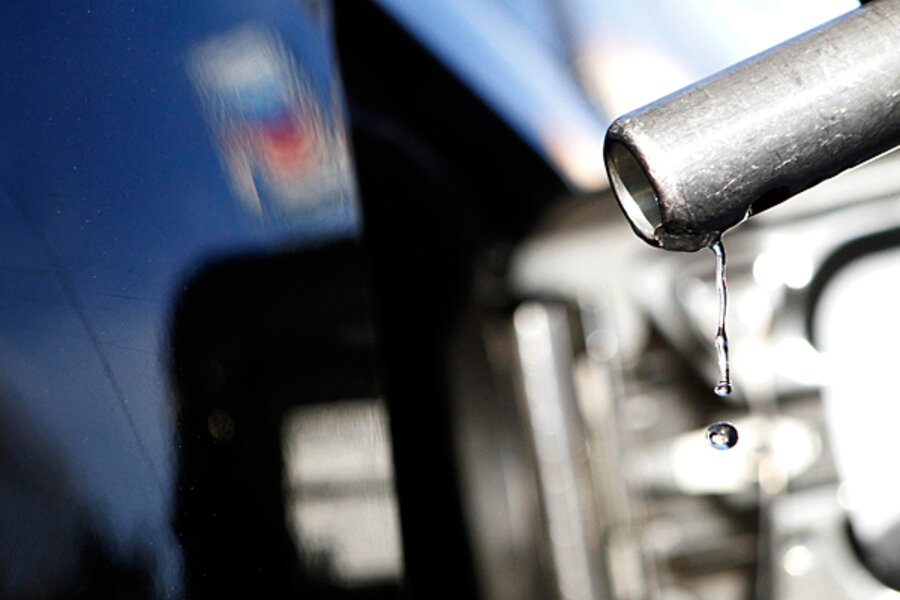Gas prices dip, but are still pretty high. Should Obama be worried?
Loading...
| New York
There is probably no one watching the gasoline price trends more closely than the Obama campaign.
That’s because when it comes to everyone’s personal economic indicator, there is nothing quite like the price at the pump.
Almost everyone knows what they paid for their last fill-up, and consumers have a rough idea of what fuel should cost at any given time of year.
What’s more, high fuel prices often result in more than grumbling: consumers cut down on discretionary items such as ice cream or trips to visit friends.
The bad news for President Obama is that suburban commuters, who are especially sensitive to higher gas prices, are part of what analysts say is an important constituency this election year. The good news is that on Monday, prices at the pump were a nickel a gallon less than they were last week, according to the AAA automobile club.
Nevertheless, at $3.81 a gallon gas is still relatively expensive for this time of year. And prices are fairly close to where they were in 2008 when they hit as high as $3.86 a gallon on Sept. 17 of that election year.
“Consumers are not used to seeing gasoline prices this high, this time of year,” says Patrick DeHaan, a Chicago-based senior petroleum analyst at GasBuddy.com, an on-line source of gas prices. “If you’re not feeling good at the pump, you’re not feeling good in your wallet.”
High gasoline prices are especially noticeable in some key swing states: Michigan ($3.90 a gallon), Wisconsin ($3.90), Pa. ($3.90) and Iowa ($3.82). “There have been pipeline outages, refinery blips – it’s been a hard year for motorists in the Midwest,” says Mr. DeHaan.
High fuel prices are also sapping the pockets of the poor, who tend to vote Democratic, and are probably irritating commuters, who are critical swing voters.
But, will voter unhappiness at the pump translate into votes for Mitt Romney?
“Historically, high gas prices have been bad for incumbent presidents,” answers Herman Schwartz, a professor of politics at the University of Virginia.
For example, there have been five elections where gas prices may have had an impact: in 1976, when Gerald Ford lost to Jimmy Carter; in 1980, when Mr. Carter lost to Ronald Reagan; in 1992, when George H.W. Bush lost to Bill Clinton; in 2000, when Al Gore lost to George W. Bush; and in 2008, when John McCain lost to Obama.
The Obama administration is more than aware of the danger to their reelection campaign. Last week there were rumors the Department of Energy was considering releasing oil from the Strategic Petroleum Reserve.
Mr. Schwartz points out that high gasoline prices adversely affect poor people the most. However, he says, the poor don’t vote in the same numbers as do the middle class. “They are half as likely to vote as higher income people,” he says.
For the Republicans, blaming Mr. Obama for high gasoline prices this late in the game could be difficult, says Shaun Bowler, associate dean for social sciences at UC Riverside.
“Even if the GOP wanted to make hay, they would have to change messages and there are only so many words you can get in an ad,” says Mr. Bowler. “It could confuse the voters – one day you’re blaming Obama for unemployment, the next day for deficit, another day for not supporting Israel, and then for gasoline prices. It’s kind of like piling on.”
However, Mr. Bowler observes the high gasoline prices are probably hurting commuters, who live in the suburbs. According to some analysts, one of the keys to victory in November for either candidate is winning the suburban vote.
“I guess if you live in the suburbs, gasoline prices are on your list of complaints,” he says.
Schwartz says one of the most important factors is how long gasoline prices remain high. “If they start to recede they will have much less impact than the run-up to the financial crisis,” he says referring to 2008 when gasoline prices peaked at $4.11 a gallon.
Gasoline prices may be starting to fall, says Avery Ash, manager of regulatory affairs for AAA in Washington. “We have seen 10 consecutive days of declines,” says Mr. Ash. “There are expectations we will see a steady rate of decline from now until the end of the year.”
Prices are expected to fall in part because the summer driving season is over and the refiners are now shifting over to the winter blend of gasoline, which is less expensive to produce. In addition, refiners in the Gulf of Mexico region are finally getting back to full production in the wake of the damage done by Hurricane Isaac early this month.
“Unless we get another hurricane or there is some geo-political event that takes place,” says Ash, “prices should fall through the end of the year.”





